

Compact Muon Solenoid
LHC, CERN
| CMS-HIN-19-014 ; CERN-EP-2020-196 | ||
| Observation of forward neutron multiplicity dependence of dimuon acoplanarity in ultraperipheral PbPb collisions at $\sqrt {\smash [b]{s_{_{\mathrm {NN}}}}} = $ 5.02 TeV | ||
| CMS Collaboration | ||
| 10 November 2020 | ||
| Phys. Rev. Lett. 127 (2021) 122001 | ||
| Abstract: The first measurement of the dependence of $\gamma\gamma \to \mu^{+}\mu^{-}$ production on the multiplicity of neutrons emitted very close to the beam direction in ultraperipheral heavy ion collisions is reported. Data for lead-lead interactions at $\sqrt {\smash [b]{s_{_{\mathrm {NN}}}}} = $ 5.02 TeV, with an integrated luminosity of approximately 1.5 nb$^{-1}$, were collected using the CMS detector at the LHC. The azimuthal correlations between the two muons in the invariant mass region 8 $ < m_{\mu\mu} < $ 60 GeV are extracted for events including zero, one, or at least two neutrons detected in the forward pseudorapidity range $|{\eta}| > $ 8.3. The back-to-back correlation structure from leading-order photon-photon scattering is found to be significantly broader for events with a larger number of emitted neutrons from each nucleus, corresponding to interactions with a smaller impact parameter. This observation provides a data-driven demonstration that the average transverse momentum of photons emitted from relativistic heavy ions has an impact parameter dependence. These results provide new constraints on models of photon-induced interactions in ultraperipheral collisions. They also provide a baseline to search for possible final-state effects on lepton pairs caused by traversing a quark-gluon plasma produced in hadronic heavy ion collisions. | ||
| Links: e-print arXiv:2011.05239 [hep-ex] (PDF) ; CDS record ; inSPIRE record ; HepData record ; CADI line (restricted) ; | ||
| Figures | Summary | Additional Figures | References | CMS Publications |
|---|
| Figures | |
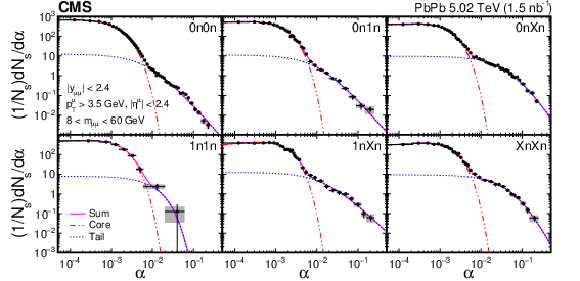
png pdf |
Figure 1:
Neutron multiplicity dependence of acoplanarity distributions from $ {\gamma \gamma \to \mu^{+} \mu^{-}} $ for $ {p_{\mathrm {T}}} ^{\mu} > $ 3.5 GeV, $ {| \eta ^{\mu} |} < $ 2.4, $ {| y^{\mu \mu} |} < $ 2.4, and 8 $ < m_{\mu \mu} < $ 60 GeV in ultraperipheral PbPb collisions at $ {\sqrt {\smash [b]{s_{_{\mathrm {NN}}}}}} = $ 5.02 TeV. The $\alpha $ distributions are normalized to unit integral over their measured range. The dot-dot-dashed and dotted lines indicate the core and tail contributions, respectively, found using a fit to Eq. (1). The vertical lines on data points depict the statistical uncertainties, while the systematic uncertainties and horizontal bin widths are shown as gray boxes. |
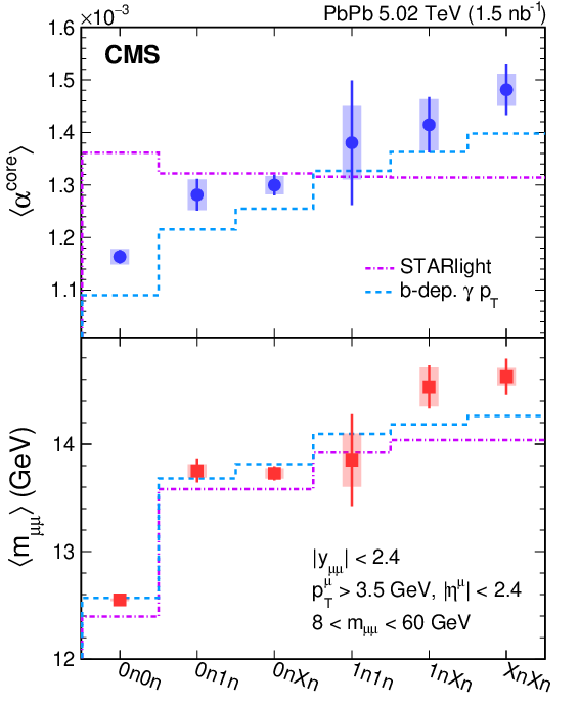
png pdf |
Figure 2:
Neutron multiplicity dependence of $ {< \alpha ^\text {core} >} $ (upper) and $ {< m_{\mu \mu} >} $ (lower) of $\mu^{+} \mu^{-} $ pairs in ultraperipheral PbPb collisions at $ {\sqrt {\smash [b]{s_{_{\mathrm {NN}}}}}} = $ 5.02 TeV. The vertical lines on data points depict the statistical uncertainties, while the systematic uncertainties of the data are shown as shaded areas. In the upper plot, the dashed-dot (red) line shows the STARlight prediction, and the dotted (black) line corresponds to the leading-order QED calculation of Ref. [43]. |

png pdf |
Figure 3:
A direct comparison between data and model calculations for the $\alpha $ distributions with $\alpha < 0.008$. The dot-dashed line shows the STARlight prediction and the dashed line corresponds to the leading-order QED calculation of Ref. [48]. The dot-dot-dashed and dotted lines indicate the core and tail contributions, respectively. The vertical lines and shaded areas represent the statistical and systematic uncertainties, respectively. |

png pdf |
Figure A1:
The left panel shows the correlation between energy distributions of the Minus and Plus ZDC detectors (one entry per event), while the right panel shows a multi-Gaussian function fit to the Minus ZDC energy distribution. |

png pdf |
Figure A2:
Acoplanarity distributions of $ {\gamma \gamma \to \mu^{+} \mu^{-}} $ events for three different neutron multiplicity classes with asymmetric neutron numbers. The solid red (open blue) symbols correspond to events where the dimuon rapidity is in the hemisphere containing larger (smaller) neutron multiplicity. The vertical lines on data points depict the statistical uncertainties while the systematic uncertainties are shown as shaded areas. |
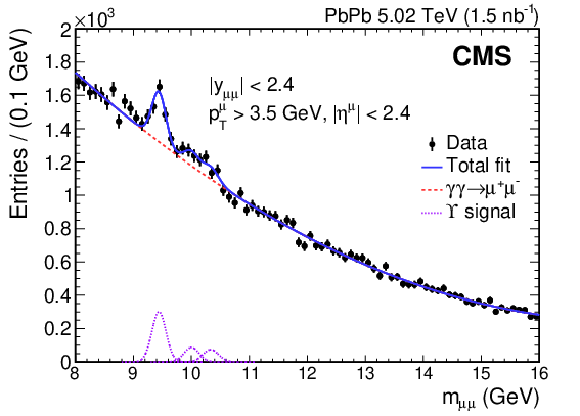
png pdf |
Figure A3:
The efficiency corrected invariant mass distribution of muon pairs in inclusive ultraperipheral Pb-Pb collisions, for the kinematic range $ {p_{\mathrm {T}}} ^{\mu} > $ 3.5 GeV, $ {| \eta ^{\mu} |} < $ 2.4, and $ {| y^{\mu \mu} |} < $ 2.4. The result of the fit to the data is shown as solid blue line. The yields of muon pairs from $ {\gamma \gamma} $ scattering in the $\Upsilon $ mass region are shown as dashed red line. The separate yields for each $\Upsilon $ state are shown as dotted violet lines. |
| Summary |
| In summary, the first measurements of $\gamma\gamma \to \mu^{+}\mu^{-}$ production as a function of forward neutron multiplicity in ultraperipheral lead-lead collisions at a nucleon-nucleon center-of-mass energy of 5.02 TeV are reported. A significant broadening of back-to-back azimuthal correlations is seen, with respect to the leading-order $\gamma\gamma \to \mu^{+}\mu^{-}$ process, for increasing multiplicities of emitted forward neutrons. This observed trend is qualitatively reproduced by a leading-order quantum electrodynamics calculation, demonstrating the importance of an impact parameter dependent photon $p_{\mathrm{T}}$. A similar trend of increasing average invariant mass of muon pairs with neutron multiplicity is also observed. These measurements provide the first experimental demonstration that the initial energy and transverse momentum of photons exchanged in ultraperipheral heavy ion collisions depend on the impact parameter of the interaction. These results call for theoretical efforts to improve the precision in modeling photon-induced interactions. Future searches for electromagnetic interactions of leptons inside the quark-gluon plasma created in heavy ion collisions should incorporate a baseline where the initial broadening effects presented in this Letter are properly taken into account. |
| Additional Figures | |

png pdf |
Additional Figure 1:
Neutron multiplicity integrated acoplanarity distribution from $ \gamma\gamma \to \mu^{+}\mu^{-} $ for $ p_{\mathrm{T}}^{\mu} > $ 3.5 GeV, $ |\eta^{\mu}| < $ 2.4, $ |y^{\mu\mu}| < $ 2.4, and 8 $ < m_{\mu\mu} < $ 60 GeV in ultraperipheral Pb-Pb collisions at $ \sqrt{\smash[b]{s_{_{\mathrm{NN}}}}} = $ 5.02 TeV. The $ \alpha $ distribution is normalized to unit integral over its measured range. The dot-dot-dashed and dotted lines indicate the core and tail contributions, respectively, found using a fit to Eq. (1). The vertical lines on data points depict the statistical uncertainties, while the systematic uncertainties and horizontal bin widths are shown as gray boxes. |
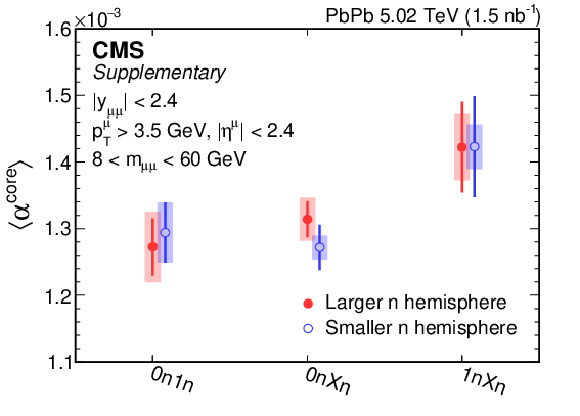
png pdf |
Additional Figure 2:
Distribution of $ \langle \alpha^\text{core} \rangle $ of $ \mu^{+}\mu^{-} $ pairs in $ \gamma\gamma \to \mu^{+}\mu^{-} $ events for three different neutron multiplicity classes with asymmetric neutron numbers. The solid red (open blue) circles correspond to events where the dimuon rapidity is in the hemisphere containing larger (smaller) neutron multiplicity. The vertical lines on data points depict the statistical uncertainties, while the systematic uncertainties of the data are shown as shaded areas. |
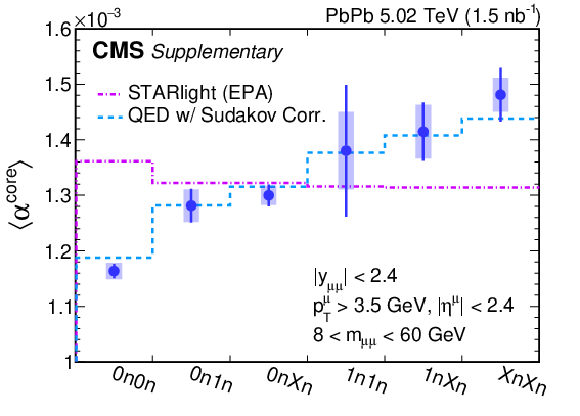
png pdf |
Additional Figure 3:
Neutron multiplicity dependence of $ \langle \alpha^\text{core} \rangle $ of $ \mu^{+}\mu^{-} $ pairs in ultraperipheral Pb-Pb collisions at $ \sqrt{\smash[b]{s_{_{\mathrm{NN}}}}} = $ 5.02 TeV. The vertical lines on data points depict the statistical uncertainties, while the systematic uncertainties of the data are shown as shaded areas. The dot-dashed line shows the STARLIGHT prediction, and the dashed line corresponds to the QED calculation of Ref. [48] incorporating Sudakov radiative corrections in addition. |
| References | ||||
| 1 | E. J. Williams | Nature of the high energy particles of penetrating radiation and status of ionization and radiation formulae | PR 45 (1934) 729 | |
| 2 | C. F. von Weizsacker | Radiation emitted in collisions of very fast electrons | Z. Phys. 88 (1934) 612 | |
| 3 | C. A. Bertulani and G. Baur | Electromagnetic processes in relativistic heavy ion collisions | Phys. Rep. 163 (1988) 299 | |
| 4 | G. Baur et al. | Coherent $ \gamma \gamma $ and $ \gamma $A interactions in very peripheral collisions at relativistic ion colliders | Phys. Rep. 364 (2002) 359 | hep-ph/0112211 |
| 5 | C. A. Bertulani, S. R. Klein, and J. Nystrand | Physics of ultra-peripheral nuclear collisions | Annu. Rev. Nucl. Part. Sci. 55 (2005) 271 | nucl-ex/0502005 |
| 6 | A. J. Baltz et al. | The physics of ultraperipheral collisions at the LHC | Phys. Rep. 458 (2008) 1 | 0706.3356 |
| 7 | S. R. Klein and P. Steinberg | Photonuclear and two-photon interactions at high-energy nuclear colliders | Annu. Rev. Nucl. Part. Sci. 70 (2020) 323 | 2005.01872 |
| 8 | A. J. Baltz, Y. Gorbunov, S. R. Klein, and J. Nystrand | Two-photon interactions with nuclear breakup in relativistic heavy ion collisions | PRC 80 (2009) 044902 | 0907.1214 |
| 9 | G. Baur, K. Hencken, and D. Trautmann | Electron-positron pair production in relativistic heavy ion collisions | Phys. Rep. 453 (2007) 1 | 0706.0654 |
| 10 | STAR Collaboration | Production of $ e^+e^- $ pairs accompanied by nuclear dissociation in ultra-peripheral heavy ion collision | PRC 70 (2004) 031902 | nucl-ex/0404012 |
| 11 | STAR Collaboration | Measurement of $ e^+e^- $ momentum and angular distributions from linearly polarized photon collisions | PRL 127 (2021) 052302 | 1910.12400 |
| 12 | PHENIX Collaboration | Photoproduction of J/$ \psi $ and of high mass $ e^+e^- $ in ultra-peripheral Au+Au collisions at $ \sqrt{\smash[b]{s_{_{\mathrm{NN}}}}} = $ 200 GeV | PLB 679 (2009) 321 | 0903.2041 |
| 13 | ALICE Collaboration | Charmonium and $ e^+e^- $ pair photoproduction at mid-rapidity in ultra-peripheral PbPb collisions at $ \sqrt{\smash[b]{s_{_{\mathrm{NN}}}}} = $ 2.76 TeV | EPJC 73 (2013) 2617 | 1305.1467 |
| 14 | CMS Collaboration | Evidence for light-by-light scattering and searches for axion-like particles in ultraperipheral PbPb collisions at $ \sqrt{\smash[b]{s_{_{\mathrm{NN}}}}} = $ 5.02 TeV | PLB 797 (2019) 134826 | CMS-FSQ-16-012 1810.04602 |
| 15 | ATLAS Collaboration | Evidence for light-by-light scattering in heavy-ion collisions with the ATLAS detector at the LHC | Nat. Phys. 13 (2017) 852 | 1702.01625 |
| 16 | ATLAS Collaboration | Observation of light-by-light scattering in ultraperipheral PbPb collisions with the ATLAS detector | PRL 123 (2019) 052001 | 1904.03536 |
| 17 | R. Bruce et al. | New physics searches with heavy-ion collisions at the CERN Large Hadron Collider | JPG 47 (2020) 060501 | 1812.07688 |
| 18 | STAR Collaboration | Coherent $ \rho^0 $ production in ultraperipheral heavy ion collisions | PRL 89 (2002) 272302 | nucl-ex/0206004 |
| 19 | STAR Collaboration | Coherent diffractive photoproduction of $ \rho^0 $ mesons on gold nuclei at 200 GeV/nucleon-pair at the Relativistic Heavy Ion Collider | PRC 96 (2017) 054904 | 1702.07705 |
| 20 | ALICE Collaboration | Coherent J/$\psi $ photoproduction in ultra-peripheral PbPb collisions at $ \sqrt{\smash[b]{s_{_{\mathrm{NN}}}}} = $ 2.76 TeV | PLB 718 (2013) 1273 | 1209.3715 |
| 21 | ALICE Collaboration | Exclusive J/$ \psi $ photoproduction off protons in ultra-peripheral p-Pb collisions at $ \sqrt{\smash[b]{s_{_{\mathrm{NN}}}}} = $ 5.02 TeV | PRL 113 (2014) 232504 | 1406.7819 |
| 22 | ALICE Collaboration | Coherent J/$ \psi $ photoproduction at forward rapidity in ultra-peripheral Pb-Pb collisions at $ \sqrt{\smash[b]{s_{_{\mathrm{NN}}}}} = $ 5.02 TeV | PLB 798 (2019) 134926 | 1904.06272 |
| 23 | CMS Collaboration | Coherent J/$ \psi $ photoproduction in ultra-peripheral PbPb collisions at $ \sqrt{\smash[b]{s_{_{\mathrm{NN}}}}} = $ 2.76 TeV with the CMS experiment | PLB 772 (2017) 489 | CMS-HIN-12-009 1605.06966 |
| 24 | CMS Collaboration | Measurement of exclusive $ \Upsilon $ photoproduction from protons in pPb collisions at $ \sqrt{\smash[b]{s_{_{\mathrm{NN}}}}} = $ 5.02 TeV | EPJC 79 (2019) 277 | CMS-FSQ-13-009 1809.11080 |
| 25 | CMS Collaboration | Measurement of exclusive $ \rho(770)^0 $ photoproduction in ultraperipheral pPb collisions at $ \sqrt{\smash[b]{s_{_{\mathrm{NN}}}}} = $ 5.02 TeV | EPJC 79 (2019) 702 | CMS-FSQ-16-007 1902.01339 |
| 26 | STAR Collaboration | Low-$ p_\mathrm{T}$ $e^{+}e^{-} $ pair production in Au+Au collisions at $ \sqrt{\smash[b]{s_{_{\mathrm{NN}}}}} = $ 200 GeV and U+U collisions at $ \sqrt{\smash[b]{s_{_{\mathrm{NN}}}}} = $ 193 GeV at STAR | PRL 121 (2018) 132301 | 1806.02295 |
| 27 | ATLAS Collaboration | Observation of centrality-dependent acoplanarity for muon pairs produced via two-photon scattering in Pb+Pb collisions at $ \sqrt{\smash[b]{s_{_{\mathrm{NN}}}}} = $ 5.02 TeV with the ATLAS detector | PRL 121 (2018) 212301 | 1806.08708 |
| 28 | ALICE Collaboration | Measurement of an excess in the yield of J/$ \psi $ at very low $ p_{\rm T} $ in Pb-Pb collisions at $ \sqrt{\smash[b]{s_{_{\mathrm{NN}}}}} = $ 2.76 TeV | PRL 116 (2016) 222301 | 1509.08802 |
| 29 | STAR Collaboration | Observation of excess J/$ \psi $ yield at very low transverse momenta in Au+Au collisions at $ \sqrt{\smash[b]{s_{_{\mathrm{NN}}}}} = $ 200 GeV and U+U collisions at $ \sqrt{\smash[b]{s_{_{\mathrm{NN}}}}} = $ 193 GeV | PRL 123 (2019) 132302 | 1904.11658 |
| 30 | S. Klein, A. H. Mueller, B.-W. Xiao, and F. Yuan | Acoplanarity of a lepton pair to probe the electromagnetic property of quark matter | PRL 122 (2019) 132301 | 1811.05519 |
| 31 | S. Klein, A. H. Mueller, B.-W. Xiao, and F. Yuan | Lepton pair production through two photon process in heavy ion collisions | PRD 102 (2020) 094013 | 2003.02947 |
| 32 | W. Zha, J. D. Brandenburg, Z. Tang, and Z. Xu | Initial transverse-momentum broadening of Breit--Wheeler process in relativistic heavy-ion collisions | PLB 800 (2020) 135089 | 1812.02820 |
| 33 | B. L. Berman and S. C. Fultz | Measurements of the giant dipole resonance with monoenergetic photons | Rev. Mod. Phys. 47 (1975) 713 | |
| 34 | M. Broz, J. G. Contreras, and J. D. Tapia Takaki | A generator of forward neutrons for ultra-peripheral collisions: n$ \mathrm{_O^O} $n | Comput. Phys. Commun. 253 (2020) 107181 | 1908.08263 |
| 35 | CMS Collaboration | HEPData record for this analysis | link | |
| 36 | CMS Collaboration | Performance of CMS muon reconstruction in pp collision events at $ \sqrt{s}= $ 7 TeV | JINST 7 (2012) P10002 | CMS-MUO-10-004 1206.4071 |
| 37 | O. Surányi et al. | Performance of the CMS zero degree calorimeters in pPb collisions at the LHC | JINST 16 (2021) P05008 | 2102.06640 |
| 38 | CMS Collaboration | The CMS experiment at the CERN LHC | JINST 3 (2008) S08004 | |
| 39 | CMS Collaboration | The CMS trigger system | JINST 12 (2017) P01020 | CMS-TRG-12-001 1609.02366 |
| 40 | CMS Collaboration | Observation and studies of jet quenching in PbPb collisions at nucleon-nucleon center-of-mass energy = 2.76 TeV | PRC 84 (2011) 024906 | CMS-HIN-10-004 1102.1957 |
| 41 | CMS Collaboration | Supplemental Material | ZDC energy distributions and rapidity dependence of acoplanarity distributions and subtraction of $\Upsilon$ mesons, which includes Ref. [42], 2001 link |
|
| 42 | P. A. Zyla et al. (Particle Data Group) | Review of Particle Physics | Prog. Theor. Exp. Phys. 2020 (2020) 083C01 | |
| 43 | S. R. Klein et al. | STARlight: A Monte Carlo simulation program for ultra-peripheral collisions of relativistic ions | Comput. Phys. Commun. 212 (2017) 258 | 1607.03838 |
| 44 | GEANT4 Collaboration | GEANT 4---a simulation toolkit | NIM A 506 (2003) 250 | |
| 45 | I. A. Pshenichnov et al. | Mutual heavy ion dissociation in peripheral collisions at ultrarelativistic energies | PRC 64 (2001) 024903 | nucl-th/0101035 |
| 46 | I. A. Pshenichnov | Electromagnetic excitation and fragmentation of ultrarelativistic nuclei | Phys. Part. Nucl. 42 (2011) 215 | |
| 47 | ALICE Collaboration | Measurement of the cross section for electromagnetic dissociation with neutron emission in Pb-Pb collisions at $ \sqrt{\smash[b]{s_{_{\mathrm{NN}}}}} = $ 2.76 TeV | PRL 109 (2012) 252302 | 1203.2436 |
| 48 | J. D. Brandenburg et al. | Acoplanarity of QED pairs accompanied by nuclear dissociation in ultra-peripheral heavy ion collisions | 2006.07365 | |

|
Compact Muon Solenoid LHC, CERN |

|

|

|

|

|

|